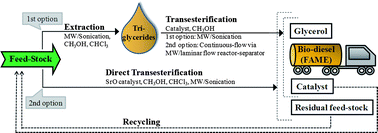Optimization of bio-diesel production from oils, cooking oils, microalgae, and castor and jatropha seeds: probing various heating sources and catalysts
Abstract
The optimization of bio-diesel production depends on numerous parameters such as renewable biological triglyceride sources, type of catalyst and alcohol for the transesterification reaction, molar ratio of oil–alcohol, and heating sources. In this review we will highlight the use of microwave (MW) radiation for bio-diesel production and its advantage over other heating sources, starting with a comparison between the two-stage method consisting of oil extraction (the first step) and bio-diesel production by transesterification (the second step), with a one-stage method that provides direct transesterification of a feed-stock without the extraction step. A comparison will be made for the one- and two-stage methods performed under microwave heating, sonication, and reflux using SrO, KOH, and NaOH catalysts for bio-diesel production. The various feed-stocks reviewed in this perspective are triolein, soybean oil, microalgae biomass of Nannochloropsis, and castor and jatropha seeds. The extension of the microwave-heating methodology to continuous-flow processing has been used to scale up the reaction. Moreover, the presented continuous-flow bio-diesel preparation is done via a novel laminar flow reactor–separator. This instrument not only enables to scale up the reaction, but also allows glycerol as a byproduct to phase separate and settle from the reacting flow.


 Please wait while we load your content...
Please wait while we load your content...